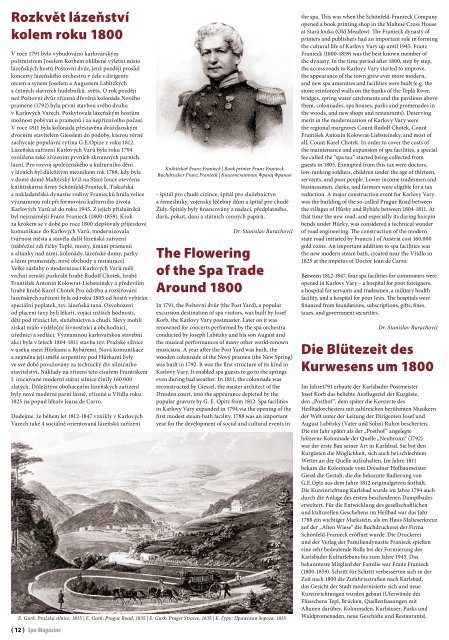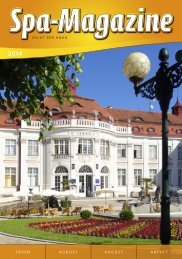Spa-Magazine
Erfolgreiche ePaper selbst erstellen
Machen Sie aus Ihren PDF Publikationen ein blätterbares Flipbook mit unserer einzigartigen Google optimierten e-Paper Software.
Rozkvět lázeňství<br />
kolem roku 1800<br />
V roce 1791 bylo vybudováno karlovarským<br />
poštmistrem Josefem Korbem oblíbené výletní místo<br />
lázeňských hostů Poštovní dvůr, jenž později proslul<br />
koncerty lázeňského orchestru v čele s dirigenty<br />
otcem a synem Josefem a Augustem Labitzkých<br />
a četných slavných hudebníků. světa. O rok později<br />
než Poštovní dvůr zřízená dřevěná kolonáda Nového<br />
pramene (1792) byla první stavbou svého druhu<br />
v Karlových Varech. Poskytovala lázeňským hostům<br />
možnost pobývat u pramenů i za nepříznivého počasí.<br />
V roce 1811 byla kolonáda přestavěna drážďanským<br />
dvorním stavitelem Giesslem do podoby, kterou věrně<br />
zachycuje populární rytina G.E.Opize z roku 1812.<br />
Lázeňská zařízení Karlových Varů byla roku 1794<br />
rozšířena také zřízením prvních skromných parních<br />
lázní. Pro rozvoj společenského a kulturního dění<br />
v lázních byl důležitým mezníkem rok 1788, kdy byla<br />
v domě domě Maltézský kříž na Staré louce otevřena<br />
knihtiskárna firmy Schönfeld-Franieck. Tiskařská<br />
a nakladatelská dynastie rodiny Franiecků hrála velice<br />
významnou roli při formování kulturního života<br />
Karlových Varů až do roku 1945. Z jejích příslušníků<br />
byl nejznámější Franz Franieck (1800-1859). Krok<br />
za krokem se v době po roce 1800 zlepšovaly příjezdové<br />
komunikace do Karlových Varů, modernizovala<br />
tvářnost města a stavěla další lázeňská zařízení<br />
(nábřežní zdi říčky Teplé, mosty, jímání pramenů<br />
a altánky nad nimi, kolonády, lázeňské domy, parky<br />
a lesní promenády, nové obchody a restaurace).<br />
Velké zásluhy o modernizaci Karlových Varů měli<br />
vrchní zemští purkrabí hrabě Rudolf Chotek, hrabě<br />
František Antonín Kolowrat-Liebsteinsky a především<br />
hrabě hrabě Karel Chotek Pro údržbu a rozšiřování<br />
lázeňských zařízení byla od roku 1805 od hostů vybírán<br />
speciální poplatek, tzv. lázeňská taxa. Osvobozeni<br />
od placení taxy byli lékaři, vojáci nižších hodností,<br />
děti pod třináct let, služebnictvo a chudí. Slevy mohli<br />
získat málo výděleční živnostníci a obchodníci,<br />
úředníci a sedláci. Významnou karlovarskou stavební<br />
akcí byla v letech 1804-1811 stavba tzv. Pražské silnice<br />
v úseku mezi Hůrkami a Rybářemi. Nová komunikace<br />
a zejména její smělé serpentiny pod Hůrkami byly<br />
ve své době považovány za technický div silničního<br />
stavitelství. Náklady na zřízení této císařem Františkem<br />
I. iniciované moderní státní silnice činily 160 000<br />
zlatých. Důležitým obohacením lázeňských zařízení<br />
byly nové moderní parní lázně, zřízené u Vřídla roku<br />
1825 na popud lékaře Jeana de Carro.<br />
Dodejme, že během let 1812-1847 vznikly v Karlových<br />
Varech také 4 sociálně orientovaná lázeňská zařízení<br />
Knihtiskař Franz Franieck | Book printer Franz Franieck<br />
Buchdrucker Franz Franieck | Книгопечатник Франц Франик<br />
- špitál pro chudé cizince, špitál pro služebnictvo<br />
a řemeslníky, vojenský léčebný dům a špitál pro chudé<br />
Židy. Špitály byly financovány z nadací, předplatného,<br />
darů, pokut, daní a státních cenných papírů.<br />
Dr. Stanislav Burachovič<br />
The Flowering<br />
of the <strong>Spa</strong> Trade<br />
Around 1800<br />
In 1791, the Poštovní dvůr (the Post Yard), a popular<br />
excursion destination of spa visitors, was built by Josef<br />
Korb, the Karlovy Vary postmaster. Later on it was<br />
renowned for concerts performed by the spa orchestra<br />
conducted by Joseph Labitzky and his son August and<br />
the musical performances of many other world-renown<br />
musicians. A year after the Post Yard was built, the<br />
wooden colonnade of the Nový pramen (the New Spring)<br />
was built in 1792. It was the first structure of its kind in<br />
Karlovy Vary. It enabled spa guests to go to the springs<br />
even during bad weather. In 1811, the colonnade was<br />
reconstructed by Giessel, the master architect of the<br />
Dresden court, into the appearance depicted by the<br />
popular gravure by G. E. Opitz from 1812. <strong>Spa</strong> facilities<br />
in Karlovy Vary expanded in 1794 via the opening of the<br />
first modest steam-bath facility. 1788 was an important<br />
year for the development of social and cultural events in<br />
E. Gurk: Pražská silnice, 1835 | E. Gurk: Prague Road, 1835 | E. Gurk: Prager Strasse, 1835 | E. Гурк: Пражская дорога, 1835<br />
the spa. This was when the Schönfeld-Franieck Company<br />
opened a book printing shop in the Maltese Cross House<br />
at Stará louka (Old Meadow). The Franieck dynasty of<br />
printers and publishers had an important role in forming<br />
the cultural life of Karlovy Vary up until 1945. Franz<br />
Franieck (1800-1859) was the best known member of<br />
the dynasty. In the time period after 1800, step by step,<br />
the access roads to Karlovy Vary started to improve,<br />
the appearance of the town grew ever more modern,<br />
and new spa amenities and facilities were built (e.g. the<br />
stone reinforced walls on the banks of the Teplá River,<br />
bridges, spring water catchments and the pavilions above<br />
them, colonnades, spa houses, parks and promenades in<br />
the woods, and new shops and restaurants). Deserving<br />
merit in the modernization of Karlovy Vary were<br />
the regional margraves Count Rudolf Chotek, Count<br />
František Antonín Kolowrat-Liebsteinsky, and most of<br />
all, Count Karel Chotek. In order to cover the costs of<br />
the maintenance and expansion of spa facilities, a special<br />
fee called the “spa tax” started being collected from<br />
guests in 1805. Exempted from this tax were doctors,<br />
low-ranking soldiers, children under the age of thirteen,<br />
servants, and poor people. Lower income tradesmen and<br />
businessmen, clerks, and farmers were eligible for a tax<br />
reduction. A major construction event for Karlovy Vary<br />
was the building of the so-called Prague Road between<br />
the villages of Hůrky and Rybáře between 1804-1811. At<br />
that time the new road, and especially its daring hairpin<br />
bends under Hůrky, was considered a technical wonder<br />
of road engineering. The construction of the modern<br />
state road initiated by Francis I of Austria cost 160,000<br />
gold coins. An important addition to spa facilities was<br />
the new modern steam bath, created near the Vřídlo in<br />
1825 at the impetus of Doctor Jean de Carro.<br />
Between 1812-1847, four spa facilities for commoners were<br />
opened in Karlovy Vary – a hospital for poor foreigners,<br />
a hospital for servants and tradesmen, a military health<br />
facility, and a hospital for poor Jews. The hospitals were<br />
financed from foundations, subscriptions, gifts, fines,<br />
taxes, and government securities.<br />
Dr. Stanislav Burachovič<br />
Die Blütezeit des<br />
Kurwesens um 1800<br />
Im Jahre1791 erbaute der Karlsbader Postmeister<br />
Josef Korb das beliebte Ausflugsziel der Kurgäste,<br />
den „Posthof“, dem später die Konzerte des<br />
Heilbadorchesters mit zahlreichen berühmten Musikern<br />
der Welt unter der Leitung der Dirigenten Josef und<br />
August Labitzky (Vater und Sohn) Ruhm bescherten.<br />
Die ein Jahr später als der „Posthof“ angelegte<br />
hölzerne Kolonnade der Quelle „Neubrunn“ (1792)<br />
war der erste Bau seiner Art in Karlsbad. Sie bot den<br />
Kurgästen die Möglichkeit, sich auch bei schlechtem<br />
Wetter an der Quelle aufzuhalten. Im Jahre 1811<br />
bekam die Kolonnade vom Dresdner Hofbaumeister<br />
Giessl die Gestalt, die die bekannte Radierung von<br />
G.E.Opiz aus dem Jahre 1812 originalgetreu festhält.<br />
Die Kureinrichtung Karlsbad wurde im Jahre 1794 auch<br />
durch die Anlage des ersten bescheidenen Dampfbades<br />
erweitert. Für die Entwicklung des gesellschaftlichen<br />
und kulturellen Geschehens im Heilbad war das Jahr<br />
1788 ein wichtiger Markstein, als im Haus Malteserkreuz<br />
auf der „Alten Wiese“ die Buchdruckerei der Firma<br />
Schönfeld-Franieck eröffnet wurde. Die Druckerei<br />
und der Verlag der Familiendynastie Franieck spielten<br />
eine sehr bedeutende Rolle bei der Formierung des<br />
Karlsbader Kulturlebens bis zum Jahre 1945. Das<br />
bekannteste Mitglied der Familie war Franz Franieck<br />
(1800-1859). Schritt für Schritt verbesserten sich in der<br />
Zeit nach 1800 die Zufahrtsstraßen nach Karlsbad,<br />
das Gesicht der Stadt modernisierte sich und neue<br />
Kureinrichtungen wurden gebaut (Uferwände des<br />
Flüsschens Tepl, Brücken, Quellenfassungen mit<br />
Altanen darüber, Kolonnaden, Kurhäuser, Parks und<br />
Waldpromenaden, neue Geschäfte und Restaurants).<br />
( 12 ) <strong>Spa</strong>-<strong>Magazine</strong>












